In the market in Syracuse we came across a traditional food that is common in Puglia, though less so here in Sicily – 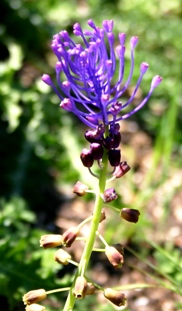 lampascioni. Similar in appearance to little onions, lampascioni are actually the bulb of a tassel hyacinth, the muscari comosum. These are a common wildflower especially in southern Italy, though few people realize that you can eat the bulb. Lampascioni are a classic example of Italian peasant cuisine, using free ingredients combined with a fair amount of labor and know-how to turn an odd edible food into a delectable dish. Or so we hoped.
lampascioni. Similar in appearance to little onions, lampascioni are actually the bulb of a tassel hyacinth, the muscari comosum. These are a common wildflower especially in southern Italy, though few people realize that you can eat the bulb. Lampascioni are a classic example of Italian peasant cuisine, using free ingredients combined with a fair amount of labor and know-how to turn an odd edible food into a delectable dish. Or so we hoped.
Emanuele remembers lampascioni from his childhood in Puglia, though he remembers little of how his Pugliese mother prepared them, other than “cutting a cross in the bottom.” I remember eating lampascioni that had been preserved in vinegar and oil as an antipasto in Puglia, but neither of us had ever cooked them.
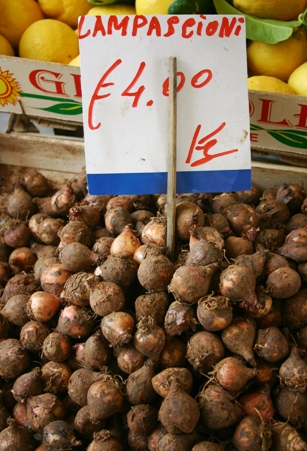 Though it felt like we were cheating to buy the lampascioni rather than dig them up, we decided it was worth it to try them out (and since this wild hyacinth is already blooming in our fields, we have the excuse that it is too late to dig them up anyway.)
Though it felt like we were cheating to buy the lampascioni rather than dig them up, we decided it was worth it to try them out (and since this wild hyacinth is already blooming in our fields, we have the excuse that it is too late to dig them up anyway.)
Emanuele began to clean them and was soon grossed out by the clear sticky liquid that came oozing out of each lampascione. Sound unappetizing? It gets worse.
We decided the sticky substance must have a scientific name, and settled on “goo”. Peeling the lampascioni with this goo oozing out makes everything stick to your hands – dirt, peel, roots, and, soon, fingers against fingers. This is what I imagine it’s like working in a glue factory, only dirtier.
“Che schifo”- how revolting, said Emanuele in disgust as he got fed up trying to clean them, and decided to toss the rest of the lampascioni into the garbage – I rescued the bulbs and planted them in a corner of the garden. If all else fails, we should have some pretty tassel hyacinths next spring.
Emanuele decided to boil the cleaned bulbs for a short while, after which he put them – still oozing goo – into a bowl and stared at them, trying to will the goo to go away. This proved ineffective.
Since Emanuele’s older sisters had spent much of their childhood in Puglia and learned to cook from their pugliese mother, I decided it was time for a lampascioni conference call. After much discussion, in which both sisters corroborated the story of the cross cut, I decided to follow this procedure:
1. The lampascioni had already been cleaned and parboiled for 15 minute. Cut a cross in the root base of each bulb – work quickly as lots more goo will start seeping out of the cross cut. 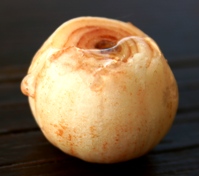
2. Put the lampascioni in a large bowl of water. Change the water 3 times a day for 2 days. The water had a slimy texture (that goo again), so I rinsed the lampascioni in a colander each time I changed the water.
3. In a stainless steel pot, make a mixture of ½ vinegar and ½ water that will amply cover the lampscioni bulbs. (I used my very strong homemade red wine vinegar, so used less vinegar. Red wine vinegar will lend a pinkish color to the lampascioni.) Bring to a boil with the lampascioni and let simmer 20 minutes, skimming off any foam.
4. Drain the lampascioni in a colander and rinse well in running water. Make another batch of water/vinegar (or just plain water if you like them less vinegary- this is what I did.)
5. Simmer the lampascioni for another 20-30 minutes until they are tender when pierced with a fork, but still hold their shape. They are resilient little buggers, so it’s hard to overcook them. This is also a dish which is impossible to make if there is water shortage.
6. Drain the cooked lampascioni and rinse well. Pat dry of excess water. There should now be no more goo seeping out of the lampascioni-hurray!
7. Put the goo-free lampascioni in a serving bowl. Like most edible things, they will immediately be improved by a good dousing of extra virgin olive oil. Add salt. Timidly taste. If they need more vinegar, add a teaspoon or two. The bulbs themselves will have a mildly bitter taste which is pleasantly countered by the vinegar and oil. If they are very bitter, you did not do a good job of getting rid of that bitter goo, and should reconsider using lampascioni in their blooming stage as decorative flowers only.
I brought my bowl of lampascioni to a family lunch in Sicily, where Emanuele’s sister Elisa was the guinea pig. I was thrilled that she proclaimed the lampascioni to be “buonissimi! “ After eating several, she then said she would add a bit more vinegar.
So, all in all the gooey lampascioni mess was a success! “Si”, Emanuele agreed, who reluctantly ate one, then looked relieved that they tasted okay and ate a few more -“sono buoni”. But next time, he swore, you can find someone else to clean them.
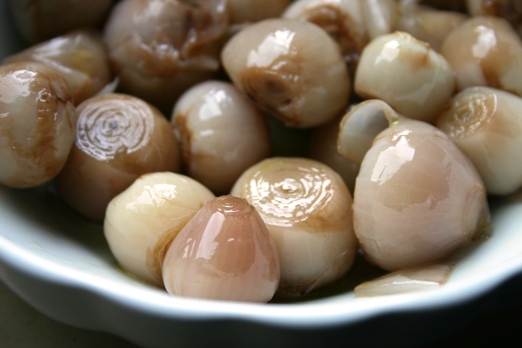

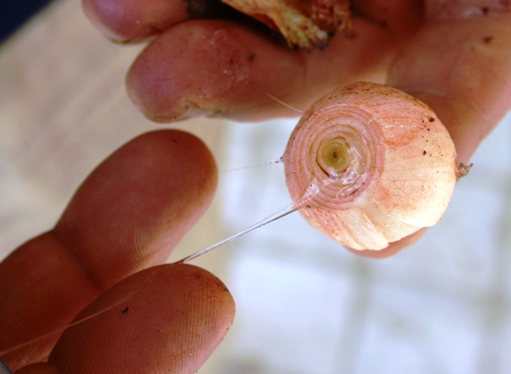
Anita, I love lampascioni! I am from Salento, the south of Puglia, and I use to eat them when their time is. I have published my recipe here http://www.thepuglia.com/2010/02/ricetta-dei-lampascioni-con-soffritto-e-vino-bianco 😉
Thanks Fabio-I’ll try your recipe next time.
Anita, My parents were from Puglia. We ate these bulbs regularly whenever they were available in the market. We called them cipollini. I buy them now from a store in NYC. They are bottled in jars.
I add them to my Veal Spezzatini . Delicious.
Hi Mike- It’s great that you can find lampascioni in New York! Interesting that you add them to a veal dish- I have only eaten them as an antipasto. Are the lampascioni that you put in your veal dish already pickled?
Hi, my parents and my husband and his family are from Molfetta Italy. My dad used to clean and cut the cross on the bottom then sauté an onion in olive oil for a bit and add them in to sauté them a bit then smashed tomato sauce with s dash of water, salt, pepper, oregano to taste and let them simmer for about 30 minutes or so in a clay pot we had especially to cook them in. I never liked them because I found them too bitter but my folks loved them and made them periodically in the winter months with a crusty loaf of Italian bread… I also never where they were attached too, I thought they were dug up from the ground. go figure!Instagram
Thank you for this method of cooking lampascioni, Anna! It sounds delicious. Yes, they are bitter – that is a trait shared by a number of wild foods that are foraged in Italy, like mustard tops, asparagus, chicory, etc, but I rather like the bitter taste, or perhaps it just gets drowned out with a sip of good wine!
The olive recipie great although my dad just smacked the olives with a hammer under a cloth no cuts as for the other too much boogers for me.
Ciao Anita
How the HECK are you? Guess how I found you again? Someone on my facebook asked what are lampascioni. I googled the word and found YOU.
Lauren
Hi Lauren- So great to hear from you… and what an odd way to find me. I’ll send you an e-mail separately. Hurray for lampascioni!
do you sell the lampascioni bulbs? I have been looking for them for a long time, my grandparents fron Italy always made these.
@Deb- I don’t sell lampascioni bulbs-a previous comment from Mike mentions buying them in NYC-dont know if that is near you. I know you can also find them already pickled in jars in some specialty food shops. Question for you- were your grandparents from the region of Puglia (Apulia) in Italy?
Just discovered website. Great job. I have strong urge to pack bags for visit to Italy. Question for Mike Gregory, where can I purchase some Lampascioni or Cipollini?? I live close to NYC and visit Arthur Ave in the Bronx frequently.
My paternal grandparents were from this area in Italy. They had very little in the way of material things…and we ate so well here in upstate New York-simple fare. I went with them as a kid to pick mustard greens and dandelion greens. Regarding lampascioni, I remember my grandmother frying them in olive oil. I’m also trying to make some ricotta forte!
Joe- So glad to hear that tis post brought back such great food memories for you- I am a big fan of wild greens, too. I will try cooking lampascioni in olive oil when they are next in season. Ricotta forte is an acquired taste, but definitely a tradition in Puglia- it will be on our list of things to taste when we are there on a new tour I am offerieng in September 2011.
Yes, that’s how my Grandmother cooked them. She fried them in olive oil. She added salt and black pepper and we ate them with Italian bread. Very bitter, but very tasty.
Sounds delicious, Al – I must try! Ciao, Anita
My father and mother cooked cippolini’s when I was a kid and I grew to love them but I have not been able to find them any longer in the USA. Does anybody know if they are still availble somewhere?
Hi Joseph-For lampascioni in oil, try an Italian Specialty food store online, such as R2M. Good luck!
Hi Anita,
I hadn’t heard of lampascioni until a short while ago. Your very funny blog has made me want to give them a go! Keep up the blog, it looks great, and if it is all as funny as this, will be a great read. Thanks x
Thanks Dan- and between laughs, you really should try eating lampascioni!
Between the popping out of the goo, and the fact that they look just like eyeballs, I don’t think I’ll ever cook lampascioni again until I’ve had them professionally prepared by a chef. Those things are nasty!
Mattie- preparing them was a fairly bizarre experience, but they do taste good. If you can’t face the preparation but are intrigued by the taste, you can purchase lampascioni already prepared in jars.
My mother-in-law would just peel them like an onion, slice and fry in oil, then add hot Italian sausage and continue frying. It was simple and delicious. The goo made them tricky to clean but definitely worth it.
Sounds delicious Linda. Will try some variations once lampascioni are in season again. Ciao, Anita
Ciao
Calabrese
Fried lamponi (cipudrizzi)
Or
Boiled
And
Spiced to favourite
Ciao Enio, I will have to try the lampascioni fried! Thanks, Anita
That’s how my mother in law always prepared them!
I came across this link because I wanted to know where lampascioni came from.Just as I am typing I have some lampascioni frying with potatoes.Deliziosi! I absolutely love them.I am from Canada and my younger brother lives in a city where he can buy them. Once a year he sends some up for me and my mom.
Anna – Glad you have a lampascioni connection! I am intrigued that you are frying them with potatoes, as I have never had them that way – please, tell us more! And buon appetito-
I have been trying to buy Lamposcioni here in Florida and New York but no one sells them. Do you have plants or roots that I can buy, because I miss not having them for years. Hoping to hear from you soon. Thank you Mrs. Irene Sanfilippo
Buongiorno Irene- I would think you might have a better chance at finding lampascioni in NY at an Italian market, most likely in early spring. Otherwise you may have to be content with buying them already prepared and pickled in jars. Or head out to the countryside with a forager and dig them up!
Anita: You should have commented on how unbelievably potent gas producers these little bombshells are! Hide the women and children after having some of these explosive bombs.
Hmmm.. Don’t recall this effect, what we call the “ceci syndrome.” Would be great to harness the energy!
Buongiorno Irene, Encontramos recentemente numa padariaI TALIANA em São Paulo,que vende a Lampascione em conserva . Minha vó que também era ITALIANA,e refogava a Lampascione com 2 tomates bem picadinhos, alho e pimenta vermelha no azeite. Experimente fica um Delicia. Abraços Tchau
Corrigindo. A Lampascione é refogada COM bastante azeite Extra Virgem.
I just bought lampascioni (cippolini) in oil only in an Italian deli. My Mom used to buy them fresh, peal them and boil them in water over & over many times to take some of the bitterness out. Then she would mash them and add vinegar & olive oil & salt & we would fight over it. Thats what I am going to do with mine. I wish I knew where to buy them fresh!!
Sounds delicious, Sonia! You’ll have to go out into the countryside and find those wild hyancinth blooms, then come back later and dig up the bulbs-
My mother always made them and still once in a while she flavors these little onions/bulbs special taste. If they are too bitter, she would put them in a frittata (eggs) and cheese. Thank you for letting me know the history of the lampascioni i.e. (small lantern). Keep on discovering our gourmet roots.
Sophia- I am glad this brought back some nice food memories of your mother’s cooking – I will try them in a frittata!
I have been growing lampascioni from seed for a few years. My earliest ones (from 10 seeds I brought back from Puglia) have been blooming for a few years. From looking at this ongoing discussion, I have an idea how to cook them, but I don’t know when to harvest the bulbs. They are starting to bloom now so I assume they should be harvested when they go dormant. But I keep reading about spring harvesting, which doesn’t make sense. Also, isn’t cippolini a small flat onion and nothing to do with lampascioni?
Hi Lynn, Congratulations an managing to grow wild hyacinth from seed! I agree that spring harvesting does not make sense, as the bulbs should be dormant. They are towrds the end of their blooming period here in Sicily (similar climate to Puglia), so I owuld harvest them in the summer or early fall, and they could be stored in a cold dry place if you don’t want to cook them right away. And yes, while lamapascioni are often referred to as little onions, they aren’t – this is an incorrect term that comes from their similarity in appearance when cooked, but as you know onions are not lampascioni! Keep in touch and let me know how yours turn out.
I live in the centre of the production area, they are ok but they are a food that’s quite unfashionable now in puglia. I’m from Lecce
We seek out the traditional, not necessarily the fashionable, regional foods. We love the city of Lecce!
Dear Anita,
I am desperately trying to find the lampascioni for a chef in CT area, I would pay dearly hot get about a pound or two.
Please advise
Thanks,
Bruce
Belllavida55@yahoo.com
Bruce- see other comments for a source of these bulbs from Holland, or google “muscari comosum” . Good luck!
You can buy lampascioni bulbs in the US from John Scheepers flowers under the name muscari comosum. They import them from Holland.
You can also buy lampascioni seeds from a seller on ebay, richters (in Canada), Weston Seeds, and B&T world seeds.
I have not been successful with the seeds, it appears they take years, not months to come up.
Thanks for the info for our US readers, John.
Cippolini and Lampuscioni are 2 different “animals”. Lampuscioni is not an onion and the taste is different. To prepare the lampuscioni, you must try to clean the bulbs as best you can, cut the roots off at the base, the cut a cross into the bottom of the bulb. Coat a baking sheet with sufficient olive oil, and place the bulbs root side down. Bake in a 325F oven until they are soft. While they are baking, mix some salt and pepper into olive oil, creating a dip. Squeeze out the Lampuscioni and dip into the olive oil mixture and enjoy. I don’t think you can find the bulbs any longer, at least in a larqe quantity. Last time I had some, they were imported from Tunisia and that was decades ago. Maybe NYC might have them. You can buy them in jars in Italy, but not as good as the fresh ones.
I married a Barese 40years ago.I learned to make these years ago with Lamb. They are a delightful counterpoint to the sweetness of Lamb,wish I could find them fresh again.
I live in Canada. I buy Lampascioni regularly at this time of the year at grocery store. They are imported from Italy and sold in bags. I have planted some in my garden (-30 or colder in the winter). They come up in the Spring and I let some go to seeds, so I pick them fresh. Very tasty and probably rich in vitamins and minerals.
I have been trying to locate a source to buy lampascioni and have been totally unsuccessful for years. I would greatly appreciate any help you might provide in finding a seller .
Thank you for your consideration.
Vince
I would google it or look in a gourmet food shop – of course, these will already be preserved or pickled.
I WOULD LIKE TO KNOW WHERE I CAN I BUY CIPOLLINI IN MILAN . THANKS IN ADVANCE.
Fabio, mille grazie. Era la ricetta che volevo. Adesso devo trovare i Lambascioni (o pure, unaltro nome e Lamboni) in California.
Grazie
Ottimo articolo. Per gli amanti (o curiosi) di questo bulbo, segnalo il sito http://www.lampascione.it
Un sito che trovo interessante e curioso
Dear Anita, I am Sicilian born, live in Australia since the age of ten; went bank to my beloved Sicily in Dec., 2011, stayed for a year; in this time I ate lampascioni quite often in season and out of season, as I love to eat, they are one of my favourite seeds, and I do know that they are the bulb of a tassel Hyacint , I have known it since a tiny child, when I would go with my siblings & cousins to fetch them for dinner, as my mother, aunts & grandma, would lovingly clean them & then roast them and lavishly drizzle them with XV olive oil of our own production; we eat them till this day, with great gusto & so do our Sicilian compatriots, I actually had them for dinner tonight: I CIPUDDUZZI (lampascioni ) are actually one of our staples. with love M.
This si probably a habit of a particular area of Sicily. For instacne, no one picks them here in the Ragusa area. I enjoyed your story.
Hello. I am looking for a place to purchase fresh uncooked lampiosini in my area or by mail. They were cooked a special way by my family who were from the Pulgia Region. They used to call them by a dialect and was pronounced
LAMBASHOONS
Any information will be greatly appreciated
Thank You …E.Pellegrini
My husband likes all “Things” pickled and my sister Sheila frequently gives him a basket of various products for Christmas and birthday. This year a jar of lampascioni was in the mix. We tried to work out what it was from the picture on the label, possibly some type of onion. However, from the taste it seemed unlikely, so I Googled it to find out what the tasty little morsel was. Hyacinth would have been last on my list of possibilities. Sheil buys all these products from Gaganis a warehouse in Adelaide, Sth Australia.
Anita, My grandparents were from Scala Coeli, and I learned to like these when I was a little girl. Unfortunately haven’t been able to find them in about 10 years. If I do locate some, do you have a recipe how to can them in jars? Thank you
As the time of year when lampascione are harvested nears ,I would like to know where in the USA you can purchsae them ? We cook them in their natural state. an old reciepe from Casalvechio Di Pulgia. any effort to help me is greatly appreciated.Grazie E.Pellegrini
It has taken me so long to find the name of these onions! My family also called them cippolini. My grandma, she was from Monteleone di Puglia, made them with veal, pieces of hard sausage and tomato and baked them in the oven. It was delicious.
My parents are from Calabria and Lampascione were a staple our Christmas Eve dinner. In our dialect from a small paese near the city of Crotone we called them “Cippudruzzi” or small onions. but we know that they are not an Onion at all. You people are all over thinking the preparation of them. You made a big deal about the “goo” and cleaning them but that is no problem. Clean them as best you can by removing the outer skin. Wash your hands periodically during the cleaning to get rid of the “goo.” After cleaning make a couple of cross cuts as mentioned above and boil gently for a few minutes in some water to tenderize. Then drain and saute in a genererous amount of Olive Oil, salt to taste and add lots of ground chili pepper. The are spicy hot and they are the food of the Gods! Eat with your favorite Calabrese meat dish or “Tiella di Bacala on Christmas Eve! They are the greatest food in world! An earthy flavour that is to die for. If I had to pick something for my last meal on earth it would be Cippudruzzi with my moms homemade Calabrese bread and some Raspy, robust Red Wine!! I am awaiting for my order of Lampascione to fly in from Toronto this week. They may cost over $14.00 lb but I would pay almost anything for these delectible morsels. Viva Calabria!!
My parents are from Calabria and Lampascione were a staple our Christmas Eve dinner. In our dialect from a small paese near the city of Crotone we called them \\
I live in Colorado and would like to cook these bulbs. Your directions on cleaning and boiling them make sense. Do I just purchase grape hyacinth bulbs from a nursery? I strongly suspect that I will not find them at the local grocery.
Do you have any idea where I can purchase lampascioni. I want the kind that I can season on my own.
I reread your article on Lampascioni and noticed you were able to buy the bulbs in Syracuse, at a market, could you tell me the name of the market and where in Syracuse it is? Thanks for the help
It’s the openair mark in the Ortigia part of Syracuse, every day but Sunday. Of course, the bulbs are only available in season.
My grandparents were from Italy, the Naples area. As a child, I enjoyed cipollini (lampascioni) which my Mom cooked around Thanksgiving and Christmas. She cut the cross in the bottom, laid them on a baking sheet and baked them in the over until tender. She then took them apart and combined them with oilive oil, seasoning and oil-cured olives. Delicioso!! You can buy them from the online grocery store Supermarket Italy.
I would like to buy a bottle of Lamponi (wild onions) could you tell me how much it cost in dollar amount. Thank You!
DO YOU HAVE ANY IDEA WHERE I CAN PURCHASE THEM TO COOK THEM NOT IN THE OIL
THANK YOU
When my mother was alive (she passed in 2010), we regularly bought lampascione at the Caputo’s grocery stores in the Chicagoland area. Our closest market is west of the city, near Aurora, Illinois. Lampascione have a limited season, but they are fairly inexpensive. Since my mother was from Bari, and most of her food names were spoken in dialect, I’m thankful to the Internet for making sense of these foods and giving me a correct spelling. I’ve gotten good at guessing probable spellings and realizing that the ends of words are often cut.
I am 92 years old and have been searching to buy some lambascione(fresh) for years.In my younger years, chippollini,as we called them was a constant part of our diet. I ask you if you can help me find some before I die.
Frank Leone
7 Covered Bridge Circle, Columbus, NJ 08022
frank.r.leone3@comcast.net
609-291-8809
609-351-2890
Saw the raw bulbs in a Milan Stret Market and googled their name and found your blog. Thank you. Fascinating. I’m glad we only looked and didn’t buy but I might look for pre-prepared ones.
Fernando-could you please tell me where to buy in
Toronto w phone #. I live in N.J. if anyone else knows
where I can purchase please let me know.
Thank You,
Pat Turi
Where can I buy them. I love them. I remember my mom and Dad would keep fresh ones in basement in a dirt pail. Love love love them!!!they say they won’t import them anymore
My grandparents used to sell them in their corner grocery store when I was a youngster. I am 73 years old now. My grandmother used to fry them in their natural state (no boiling). They were nerdy bitter, but delicious. Sometimes she would fry them with long hot peppers. My mouth is salivating, thinking of the sandwiches we would enjoy with these bitter lampascioni, hot peppers, and generously salted. We also called them cippolini.. They were imported in wicker baskets, but as I understand, it is now illegal to import them unless they are pickled in a jar. How sad.
Francis
Thanks very much for the information. Very interesting and enlightening. I had not known that what we call cipoline came from Puglia, land of my ancestors.
In the early 90’s, I bought them for the last time–at $20 a pound. I was intrigued b the comment from 2014 that they might cost $14 a pound. I also had not know they are hyacinth bulbs ; I have been trying to find out what they might be called in English. Leave it to the Italians to find another use for something, and to be creative with food. They took corn meal and made polenta, noodles and made pasta, etc.
In Greece we eat them. Ancestral food in Laconia Greece!